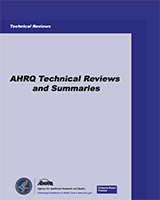NCBI Bookshelf. A service of the National Library of Medicine, National Institutes of Health.
Structured Abstract
Background:
There are several examples in nutrition of discordance between the results of observational studies and randomized controlled trials (RCTs). We hypothesized that this discordance is attributable to differences in the translational paths of nutrient–disease associations. Translational paths can be assessed using citation analysis.
Objective:
We set out to empirically explore our hypothesis by analyzing and comparing characteristics of the citation networks in two nutritional associations with disease: one where the two research designs generally agree and one where they disagree.
Study Design and Setting:
We compared the characteristics of citation networks using examples where RCTs and observational studies agreed (long chain n-3 polyunsaturated fatty acids [n-3 PUFA]) or disagreed (vitamin E). We performed systematic reviews in each example, constructed citation networks, and compared them with respect to the number of articles and citation relationships between them, as well as the distribution of articles' hub and authority scores.
Results:
For n-3 PUFA, meta-analyses of 14 RCTs and 10 observational studies both suggested that higher intake was associated with lower cardiovascular mortality. For vitamin E, the meta-analysis of 14 RCTs excluded a clinically significant effect, whereas 14 observational studies reported a significant inverse association. The respective citation networks consisted of 392 (n-3 PUFA) and 351 (vitamin E) articles. No differences between the characteristics of the two networks were identified. There was no evidence that observational studies predated RCTs in the translational process in either example.
Conclusion:
In the two examples, citation network characteristics do not predict concordance in the results of observational studies and RCTs.
Contents
Prepared for: Agency for Healthcare Research and Quality, U.S. Department of Health and Human Services1, Contract No. HHSA 290-2007-100551.Prepared by: Tufts Medical Center Evidence-based Practice Center, Boston, Massachusetts
Suggested citation:
Trikalinos TA, Moorthy D, Chung M, Yu WW, Lee J, Lichtenstein AH, Lau J. Comparison of Translational Patterns in Two Nutrient-Disease Associations. Technical Review 17, Vol. 5. (Prepared by the Tufts Medical Center Evidence-based Practice Center under Contract No. HHSA 290-2007-100551.) AHRQ Publication No. 11(12)-EHC084-EF. Rockville, MD: Agency for Healthcare Research and Quality. October 2011. www.effectivehealthcare.ahrq.gov
This report is based on research conducted by the Tufts Medical Center Evidence-based Practice Center under contract to the Agency for Healthcare Research and Quality (AHRQ), Rockville, MD (Contract No. HHSA 290-2007-100551). The findings and conclusions in this document are those of the author(s), who are responsible for its contents; the findings and conclusions do not necessarily represent the views of AHRQ. Therefore, no statement in this report should be construed as an official position of AHRQ or of the U.S. Department of Health and Human Services.
The information in this report is intended to help health care decisionmakers—patients and clinicians, health system leaders, and policymakers, among others—make well-informed decisions and thereby improve the quality of health care services. This report is not intended to be a substitute for the application of clinical judgment. Anyone who makes decisions concerning the provision of clinical care should consider this report in the same way as any medical reference and in conjunction with all other pertinent information, i.e., in the context of available resources and circumstances presented by individual patients.
This report may be used, in whole or in part, as the basis for development of clinical practice guidelines and other quality enhancement tools, or as a basis for reimbursement and coverage policies. AHRQ or U.S. Department of Health and Human Services endorsement of such derivative products may not be stated or implied.
No investigators have any affiliations or financial involvement (e.g., employment, consultancies, honoraria, stock options, expert testimony, grants or patents received or pending, or royalties) that conflict with material presented in this report.
- 1
540 Gaither Road, Rockville, MD 20850; www
.ahrq.gov.
- NLM CatalogRelated NLM Catalog Entries
- Concordance of randomized and nonrandomized studies was unrelated to translational patterns of two nutrient-disease associations.[J Clin Epidemiol. 2012]Concordance of randomized and nonrandomized studies was unrelated to translational patterns of two nutrient-disease associations.Trikalinos TA, Moorthy D, Chung M, Yu WW, Lee J, Lichtenstein AH, Lau J. J Clin Epidemiol. 2012 Jan; 65(1):16-29. Epub 2011 Nov 1.
- Review Concordance Between the Findings of Epidemiological Studies and Randomized Trials in Nutrition: An Empirical Evaluation and Citation Analysis: Nutritional Research Series, Vol. 6[ 2013]Review Concordance Between the Findings of Epidemiological Studies and Randomized Trials in Nutrition: An Empirical Evaluation and Citation Analysis: Nutritional Research Series, Vol. 6Moorthy D, Chung M, Lee J, Yu WW, Lau J, Trikalinos TA. 2013 May
- Review Low-Dose Aspirin for the Prevention of Morbidity and Mortality From Preeclampsia: A Systematic Evidence Review for the U.S. Preventive Services Task Force[ 2014]Review Low-Dose Aspirin for the Prevention of Morbidity and Mortality From Preeclampsia: A Systematic Evidence Review for the U.S. Preventive Services Task ForceHenderson JT, Whitlock EP, O'Conner E, Senger CA, Thompson JH, Rowland MG. 2014 Apr
- Review Primary Care Screening for Abdominal Aortic Aneurysm: A Systematic Evidence Review for the U.S. Preventive Services Task Force[ 2014]Review Primary Care Screening for Abdominal Aortic Aneurysm: A Systematic Evidence Review for the U.S. Preventive Services Task ForceGuirguis-Blake JM, Beil TL, Sun X, Senger CA, Whitlock EP. 2014 Jan
- Review Treatment Strategies for Patients With Peripheral Artery Disease[ 2013]Review Treatment Strategies for Patients With Peripheral Artery DiseaseJones WS, Schmit KM, Vemulapalli S, Subherwal S, Patel MR, Hasselblad V, Heidenfelder BL, Chobot MM, Posey R, Wing L, et al. 2013 May
- Comparison of Translational Patterns in Two Nutrient-Disease AssociationsComparison of Translational Patterns in Two Nutrient-Disease Associations
Your browsing activity is empty.
Activity recording is turned off.
See more...
